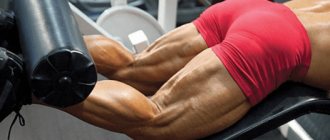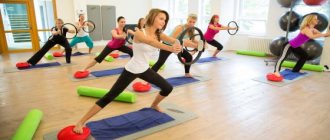Any sport involves energy expenditure. How many calories will be burned during a workout depends on its duration, intensity of exercise, weight and gender, individual parameters of a person and a huge number of other factors. As a rule, people purposefully select the most energy-intensive exercises in order to lose excess weight. Energy can be spent in different ways, in this material you will find recommendations on how to burn more calories in the gym, swimming pool and without leaving home.
It is a mistake to believe that the most energy-intensive workouts are performed with heavy weights. The most calories are burned when performing basic exercises. They can be done with or without weight, in any case, many large muscles will be involved, which will result in a lot of energy being spent on performing. It is also worth noting plyometric exercises, these are jumping, jumping squats, burpees, plank jumps and others, they can be used to create a full workout.
Basic exercises are technically difficult, since they work a large number of joints and muscles, including stabilizer muscles. You can understand how complex and coordinated this work is by using the example of squats. The main participants in this natural movement for humans are three pairs of gluteal muscles (small, medium and large) and the quadriceps femoris muscle. In total, these are already seven muscles, not counting the auxiliary muscles: biceps femoris, back muscles, gastrocnemius and soleus, abdominal muscles and others. If you squat with dumbbells or a barbell, then the shoulder girdle is also included in the active work.
The most effective basic exercises are weighted squats, deadlifts and bench presses. In addition to them, there are many more techniques that shift the focus to a specific muscle group. For example, bent-over barbell rows and pull-ups on the horizontal bar put more stress on your back. If you do a military press or a push-up, pulling weights to the chin in a standing position, then the emphasis will be on the deltoids. To focus more on your legs, you can do lunges, squats, and deadlifts. The chest develops during dips and various presses.
Plyometrics are those activities in which the muscles will quickly stretch and contract. They are used not only as the most energy-intensive exercises for weight loss, but in training to develop explosive strength, general endurance, and coordination of movements. Burning a high amount of calories is due to a combination of strength and cardio effects.
There are many such techniques, and they are all effective: running with high knees, running on all fours and in a horizontal position, jumping in a plank with legs spread and back and forth, just high jumps and lunges or with a turn, jumping squats, push-ups with clapping, burpees, jumping jack.
In order to conduct a productive workout, it is not enough to know the names of the most energy-consuming techniques. It is necessary to correctly combine them into a training program, taking into account your level of development. Beginners will not be able to immediately start doing the most difficult exercises and conduct 3-4 classes per week. If your physical fitness is poor, rest between classes should be 3-4 days. The training should be feasible, but breaks between approaches and exercises should not exceed 30 seconds, otherwise the meaning is lost.
Basic exercises
These are technically complex movements that involve many muscles and joints, as well as stabilizer muscles. Using the example of squats with a barbell, you can understand that almost all the muscles of the human body work when performing the movement.
Main muscles involved in squats:
- Quadriceps femoris muscles.
- Gluteal muscles.
If we consider only these groups in detail, then seven muscles are already involved (in total). Accessory muscles (stabilizers and anchors):
- Back muscles.
- Biceps femoris muscles.
- Twins.
- Soleus and gastrocnemius.
- Anterior tibialis.
- Finger extensors.
- Short and long fibulae.
- Abdominal muscles.
Safety regulations
When not to do cardio.
In order for sports to bring only positive results, you should remember about contraindications to special types of stress. For example, you cannot do cardio during menstruation, with problems in the cardiovascular system, in the stages of exacerbation of chronic diseases, with ARVI or asthma, with varicose veins, hernias and obesity. Therefore, before starting serious cardio training, you should definitely consult with a specialist.
How to calculate the optimal heart rate.
If there are no contraindications, you can proceed to finding the optimal heart rate at which you will need to train. Heart rate is calculated using the formula: 220 minus your age. From the obtained value, the optimal heart rate is calculated for low (40% of the number), medium (60%) and high (90%) intensity loads. You need to exercise only in the pulse zone, otherwise training is fraught with possible problems with the functioning of the heart and blood vessels, the appearance of seizures and other unpleasant consequences.
What loads are permissible?
If you are just starting to train, you should start with low-intensity loads, gradually increasing and complicating them. In the first month, no more than 150 minutes of aerobic exercise and 75 minutes of intense exercise are allowed throughout the week. That is, you can spend no more than 25 minutes a day on aerobic exercise, and no more than 10 minutes on more serious training. This will strengthen the muscles and heart, without overloading the body and will start the fat burning process.
What exercises are considered basic?
In addition to the golden or royal three (bench press, deadlift and barbell squats), there are a lot of different exercises that focus on each muscle group. For back muscles:
- Pull-ups.
- Bent-over barbell row.
For the deltoids:
- Army press.
- Standing barbell or dumbbell rows to the chin.
- Shvung press.
For leg muscles:
- Squats.
- Lunges.
- Deadlift.
For the pectoral muscles:
- Dips.
- Various presses (barbells and dumbbells).
Benefits of barbell exercises for weight loss
Both women and men can do the barbell; you just need to choose the right set to achieve your goal. There are several advantages of this method of getting rid of extra pounds:
- Barbell exercises are a slow but effective method of losing weight. While performing them, a person begins to breathe actively, his lungs absorb a lot of air, and blood circulation accelerates. All tissues are saturated with oxygen, which leads to the burning of calories. The same effect can be achieved by running, but it is difficult and, for some people, dangerous.
- With regular exercise, muscle mass increases. In terms of weight loss, this is very useful because the muscles themselves burn calories. Even if a person is at rest, independent weight loss occurs. As a person gains muscle mass, he or she will need more calories for an active lifestyle, eliminating the need to adhere to strict diets, limit food intake, and give up favorite foods.
Group exercises with barbells
- Ligaments, joints, tendons work in comfortable conditions. Any exercises are performed calmly, without jerking, there is no need to “tear” the muscles. After just 15 minutes of intense exercise, a person becomes tired, feels tension in the muscles, and sweats increase. To achieve the same effect, you need to perform at least 100 abdominal exercises and run on a treadmill for at least 40 minutes at high speed.
- Just 2 - 3 exercises make all the muscles of the body work. This means that you don’t need to devote separate time to your abs, buttocks, and waist. By performing a set of exercises, you can lose weight in all parts of the body at once.
And one more advantage of such weight loss is that if you perform the exercises correctly and follow the trainer’s recommendations, you will not need to fight loose, sagging skin. And this moment confuses many, forcing them not only to carry out expensive and complex cosmetic procedures, but also to turn to plastic surgeons - “extra” skin inevitably appears when losing weight.
We recommend reading about a vacuum massager for weight loss. You will learn about the advantages and disadvantages of a vacuum massager, their types and features, and rules of use. And here is more information about electric massagers for weight loss.
Plyometric exercises
These exercises are based on rapid stretching and contraction of muscles. They are an excellent option for training endurance, explosiveness and coordination. They are also very energy-consuming. These exercises combine cardio and strength training. Athletes of many sports actively use these exercises in their training. Plyometric exercises:
- Jumpin Jacks.
- Jumping with legs spread in the plank.
- Running with high knees.
- Skater.
- Skier.
- Horizontal running.
- Jumping lunges.
- Plank jumps (back and forth).
- Jumps 180 degrees.
- Kicks forward.
- Running in table position.
- Jump squats.
- High jumps.
- Push-ups with clap.
- Burpee.
- X-jumps.
- Kicks to the buttocks in the plank.
Read more about plyometrics →
Features of nutrition after intense squats and other exercises with a barbell
Many trainers recommend combining exercise and the use of special sports nutrition - protein bars, drinks. But this is only necessary if the goal is to build muscle mass. To lose weight with a barbell, there are other recommendations regarding nutrition for women and men:
- You need to give up sweets. If this is problematic, then all fatty confectionery products are replaced with dried fruits, honey, marshmallows and marshmallows with marmalade. These sweets are considered the safest for your figure, but you don’t need to get carried away with them either.
- The diet must contain proteins, so a vegetarian diet in combination with barbell exercises is unacceptable. Meat, fish, dairy products, eggs - they can be consumed daily, but with minimal added fat.
For example, it is better to boil or bake meat, eat eggs raw or boiled, and stew fish in its own juice with vegetables.
- The last meal before training should take place no later than an hour and a half before. It is better if the meal includes an egg omelet cooked in the oven, cottage cheese with sour cream, a boiled piece of meat, and a milkshake.
- After training, you are allowed to drink a cup of tea without sugar, but eating can be done no earlier than one and a half to two hours after training. And it’s better if it’s vegetables, fruits, and dairy products.
If you regularly lift weights, but do not change your usual diet, then there will be no weight loss effect.
We recommend reading about Hot shapers weight loss breeches. You will learn about the features and rules of wearing Hot shapers, contraindications, choosing a size, cost. And here is more information about the myostimulator belt for weight loss.
Barbell exercises for weight loss are really effective. They must be performed using the correct technique; it is better to do this under the supervision of a specialist. A barbell is not always mountains of muscles; exercises help both women and men lose weight effectively and safely.
How to build a training process in the gym using energy-intensive exercises?
It’s worth noting right away that such training is not suitable for beginner athletes, and the traditional scheme of 3-4 training days will not work either. The training process should be structured as follows:
- An equal interval should be taken between workouts: 3-4 days.
- The duration of the workout should not exceed 60 minutes.
- The rest time between approaches and exercises is as short as possible (30 seconds).
Here is an example of a combined workout:
- Squats.
- Jumpin Jacks.
- Romanian cravings.
- Plank jumps back and forth.
- Barbell bench press.
- Push-ups with clapping.
- Dips.
- Burpee.
All workouts here →
Jumping rope
This popular childhood activity allows you to burn more calories than running. The faster the jumps, the more effective the training.
To “turn on” the fat burning mode, you need to do at least 70 revolutions per minute. And you can rest no more than the notorious 60 seconds between approaches to maintain the desired heart rate.
Jumping rope allows you to work out the most problematic areas of the body - the abs and thighs; the load on the back and calves is also high. 10 minutes of jumping rope is an alternative to 3 km of cycling.
Read more in the article “How to lose weight by jumping rope.”
What to choose: group or individual fitness training
All training can be roughly divided, just like sports, into group and individual. Each of them has its own disadvantages and advantages; we’ll talk about this in more detail below.
Group (collective) fitness training
Group exercises are considered an acceptable option for people who are open to new acquaintances and whose goal is to lose weight and strengthen their heart and muscles.
Benefits of group training (+):
- The training takes place under the guidance of a professional trainer.
- Contact with like-minded people, new acquaintances
- Self-control of visits (no one urges you, no one reminds you that tomorrow is a training session) is a controversial point, for some it is a minus.
- Low price tag for a subscription
Flaws (-)
- No one is pushing you to go to training (for some this is useful)
- There is no individual approach (if you make mistakes, then no one will work with you to correct them)
- Limited training time, meaning you will have to adapt to your training schedule
We recommend choosing group training for weight loss for those people who are not used to “taking everything into their own hands” and who, for one reason or another, are embarrassed to have close contact with a trainer. That is, when attending a collective training session, you will repeat all the movements after an experienced trainer, who is most often located in the center of the gym, and you will “dissolve” in the crowd, that is, you will not feel any discomfort from individual communication: you came and repeated the movements, talked with the people, They discussed what successes they had and went their separate ways. And so on on an ongoing basis. For those who are used to collectivism , choose group fitness training.
Group training for weight loss
If you don’t have the time or money to visit a sports club, you can train at home. Programs have been developed that are adapted for self-study, including those using smartphones . True, such software is not very disciplined and has little control over the user, since you understand that the phone will not “punish” you and will not tell you to your face that you are a “lazy person” who is skipping training, not to mention that it will not point out your mistakes when performing certain exercises.
Therefore, if you are a beginner athlete, it will be best for you to gain experience through “live communication” with people, attending group or individual fitness training.
Individual fitness training
Individual fitness training can be divided into training sessions:
- directly with the trainer (personal training)
- individual (you do everything yourself)
The first training option is suitable for a beginner level athlete, the second option is for an experienced one who knows first-hand what overtraining, proper nutrition and recovery after physical activity are.
Flaws
- Expensive (if you choose training with a trainer)
- Lack of mutual understanding (due to close communication, it happens that a coach and his student cannot find a common “language”)
pros
- Individual approach (all the mistakes you make while doing the exercises will be immediately noticed and recommendations for correcting them will be given, as well as a number of other useful tips on nutrition and training that will naturally lead faster to your goal)
- Free schedule (you can set your own time , and the trainer will adapt to you)
- An individual training program for you (that is, taking into account your lifestyle , body type, etc., by the way, you can order it from us), and not a general one in the case of group training, which does not take into account multiple human aspects such as age, gender, daily activity , physique and so on.
Individual fitness training
As practice shows, individual training with a trainer is often chosen by wealthy people who can afford to spend 1000-2000 rubles on one training session. (average price in Russia in a prestigious fitness club).










